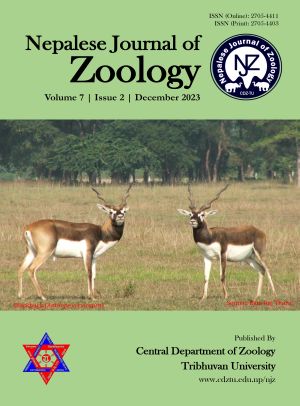Amphibian diversity and their association with water quality: A case study of the ponds of Bhaktapur, Nepal
DOI:
https://doi.org/10.3126/njz.v7i2.60808Keywords:
Diversity index, Frogs, Physicochemical parameters, Water analysisAbstract
Amphibians are noteworthy bio-indicators and bio-control agents. They have an intimate relationship with their aquatic environment. Therefore, the present study was conducted aiming to investigate the association of amphibian diversity with the Physicochemical factors of pond water. The field surveys were carried out in Rani Pokhari, Bhajya Pokhari and Gonga Pokhari of Bhaktapur Municipality during the rainy season using repeated visual encounter surveys and opportunistic observations. Surveys were made around the ponds from 06:00 to 09:00 and from 18:00 to 21:00 once a week spending three hours per visit walking along the perimeter of ponds. Water samples were collected from the four corners of each pond. The physicochemical analyses of sample water were carried out as per the scientific instrumentations and standard procedures. A total of 77 individuals of five different species of amphibians belonging to three families were documented from the study areas. The higher values of the Shannon-Wiener diversity index (H=1.34), and Simpson’s reciprocal index (1/D=3.656) were recorded for Rani Pokhari. All the ponds exhibited a high degree of Pielou’s evenness index (e>0.9). The physicochemical analysis indicated a favourable aquatic environment for amphibians in Bhajya Pokhari and Rani Pokhari and the least favorable aquatic conditions in Gonga Pokhari which supported only few tolerant species. Karl Pearson’s correlation coefficient between Shannon-Wiener diversity index and physicochemical factors revealed a positive association with temperature (r=0.997), transparency (r=0.695) and dissolved oxygen (r=0.353) while a negative association with pH, electrical conductivity, free CO2, total dissolved solids and alkalinity. The water quality of the ponds of Bhaktapur is in healthy condition for the existence of amphibians and other aquatic organisms. The information obtained is useful for implementing amphibian and pond water conservation management. In addition, this study has established baseline database of amphibians for Bhaktapur district which is valuable for the local government to maintain biodiversity profile of the district.
Downloads
Downloads
Published
How to Cite
Issue
Section
License

This work is licensed under a Creative Commons Attribution-NonCommercial 4.0 International License.
This license enables reusers to distribute, remix, adapt, and build upon the material in any medium or format for noncommercial purposes only, and only so long as attribution is given to the creator.

